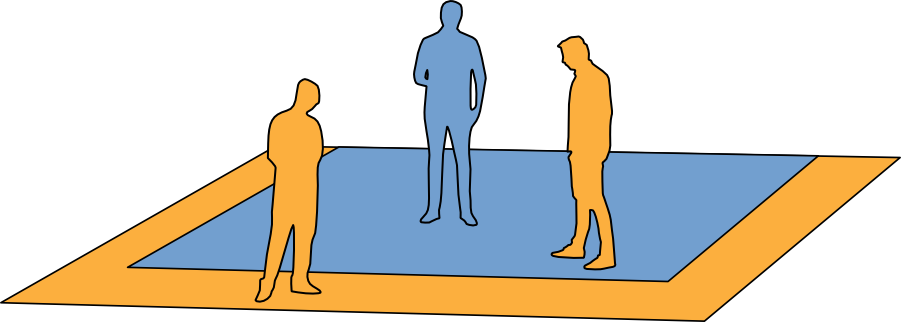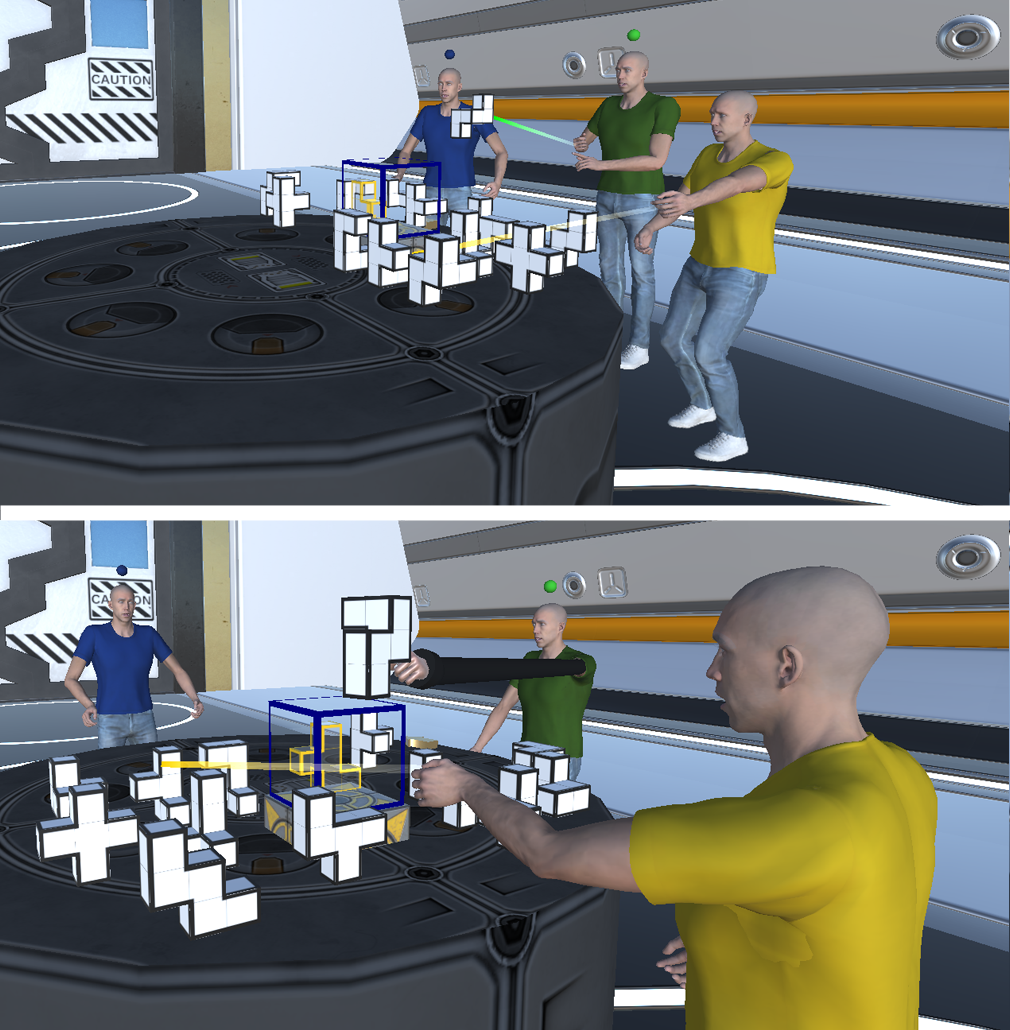Eery Space: Facilitating Virtual Meetings Through Remote Proxemics

0

Sign in to get full access
Overview
- The paper explores the concept of "remote proxemics" to facilitate virtual meetings and enhance collaboration in remote work environments.
- It investigates how spatial awareness and interpersonal distance can be simulated in virtual settings to create a more natural and immersive meeting experience.
- The research aims to improve the design of virtual collaboration tools and address the challenges faced in remote communication and interaction.
Plain English Explanation
The paper discusses ways to make virtual meetings feel more natural and engaging. When people meet in person, they naturally adjust their body language and positioning based on the situation and their relationship with others. This is called "proxemics" - the study of how people use personal space.
In virtual meetings, this sense of physical presence and personal space is often lost. The paper explores how to recreate these spatial dynamics in virtual environments, to make remote collaboration feel more intuitive and lifelike. For example, the researchers might look at how virtual avatars could move and position themselves to mimic real-world interactions.
The goal is to design virtual meeting tools that better support the way people naturally communicate and collaborate, even when they're not in the same physical space. This could help remote workers feel more connected and engaged during online meetings and discussions.
Technical Explanation
The paper investigates the concept of "remote proxemics" to enhance virtual meeting experiences. Proxemics refers to the study of how people perceive and use interpersonal space in social situations. The researchers explore ways to simulate this sense of spatial awareness and interpersonal distance in virtual environments, in order to facilitate more natural and immersive remote collaboration.
The paper reviews prior work on virtual communication, collaboration, and the challenges of replicating in-person interactions in digital spaces. It then proposes a conceptual framework for incorporating remote proxemics into the design of virtual meeting tools and environments.
The authors conducted qualitative user studies to better understand how people perceive and respond to various proxemic cues in virtual settings. They explored factors like avatar positioning, gaze, and interpersonal distance, and how these elements impact the sense of presence, engagement, and social dynamics during virtual meetings.
Based on the findings, the paper discusses design considerations and potential techniques for implementing remote proxemics in virtual collaboration platforms. The goal is to create more naturalistic and socially aware virtual meeting experiences that better support remote work and distributed teamwork.
Critical Analysis
The paper provides a thoughtful exploration of an important issue in virtual collaboration - the lack of natural spatial and social cues that are present in face-to-face meetings. By focusing on the concept of "remote proxemics," the researchers highlight a key dimension that is often overlooked in the design of virtual meeting tools.
That said, the research is still largely conceptual and the proposed techniques have not been extensively tested or validated. The user studies, while insightful, are fairly small in scale. More comprehensive evaluations would be needed to fully assess the impact and viability of incorporating remote proxemics into virtual meeting platforms.
Additionally, the paper does not deeply address potential challenges or unintended consequences of simulating proxemic behaviors in virtual spaces. Issues around privacy, personal boundaries, and the representation of diverse body types and physical abilities would be important to consider as this technology is further developed.
Overall, the paper makes a compelling case for the value of remote proxemics, but additional research is needed to translate these ideas into practical, scalable, and inclusive solutions for virtual collaboration. Continued exploration in this area could yield meaningful improvements in how people engage and interact in distributed work environments.
Conclusion
This paper presents a novel approach to improving virtual meetings by focusing on the concept of "remote proxemics" - the simulation of spatial awareness and interpersonal dynamics in digital collaboration environments.
The research highlights how the lack of natural physical cues and social positioning can hamper the sense of presence and engagement in remote work settings. By incorporating proxemic principles into the design of virtual meeting tools, the authors aim to create more intuitive and immersive online collaboration experiences.
While still largely conceptual, this work identifies an important and underexplored area for innovation in remote work technologies. Continued research and development in remote proxemics could lead to significant advancements in how distributed teams communicate, cooperate, and build meaningful connections in virtual spaces.
This summary was produced with help from an AI and may contain inaccuracies - check out the links to read the original source documents!
Related Papers


0
Eery Space: Facilitating Virtual Meetings Through Remote Proxemics
Maur'icio Sousa, Daniel Mendes, Alfredo Ferreira, Jo~ao Madeiras Pereira, Joaquim Jorge
Virtual meetings have become increasingly common with modern video-conference and collaborative software. While they allow obvious savings in time and resources, current technologies add unproductive layers of protocol to the flow of communication between participants, rendering the interactions far from seamless. In this work we introduce Remote Proxemics, an extension of proxemics aimed at bringing the syntax of co-located proximal interactions to virtual meetings. We propose Eery Space, a shared virtual locus that results from merging multiple remote areas, where meeting participants' are located side-by-side as if they shared the same physical location. Eery Space promotes collaborative content creation and seamless mediation of communication channels based on virtual proximity. Results from user evaluation suggest that our approach is effective at enhancing mutual awareness between participants and sufficient to initiate proximal exchanges regardless of their geolocation, while promoting smooth interactions between local and remote people alike. These results happen even in the absence of visual avatars and other social devices such as eye contact, which are largely the focus of previous approaches.
Read more6/4/2024


0
An Interactive Augmented Reality Interface for Personalized Proxemics Modeling
Massimiliano Nigro, Amy O'Connell, Thomas Groechel, Anna-Maria Velentza, Maja Matari'c
Understanding and respecting personal space preferences is essential for socially assistive robots designed for older adult users. This work introduces and evaluates a novel personalized context-aware method for modeling users' proxemics preferences during human-robot interactions. Using an interactive augmented reality interface, we collected a set of user-preferred distances from the robot and employed an active transfer learning approach to fine-tune a specialized deep learning model. We evaluated this approach through two user studies: 1) a convenience population study (N = 24) to validate the efficacy of the active transfer learning approach; and 2) a user study involving older adults (N = 15) to assess the system's usability. We compared the data collected with the augmented reality interface and with the physical robot to examine the relationship between proxemics preferences for a virtual robot versus a physically embodied robot. We found that fine-tuning significantly improved model performance: on average, the error in testing decreased by 26.97% after fine-tuning. The system was well-received by older adult participants, who provided valuable feedback and suggestions for future work.
Read more8/9/2024


0
Social VR for Professional Networking: A Spatial Perspective
Victoria Chang, Ge Gao, Huaishu Peng
One essential function of professional events, such as industry trade shows and academic conferences, is to foster and extend a person's connections to others within the community of their interest. In this paper, we delve into the emerging practice transitioning these events from physical venues to social VR as a new medium. Specifically, we ask: how does the spatial design in social VR affect the attendee's networking behaviors and experiences at these events? To answer this question, we conducted in-situ observations and in-depth interviews with 13 participants. Each of them had attended or hosted at least one real-world professional event taking place in social VR. We identified four elements of VR spatial design that shaped social interactions at these events: area size, which influenced a person's perceived likelihood of encountering others; pathways connecting areas, which guided their planning of the next activity to perform; magnets in areas, which facilitated spontaneous gatherings among people; and conventionality, which affected the assessment of a person's behavior appropriateness. Some of these elements were interpreted differently depending on the role of the participant, i.e., event hosts vs. attendees. We concluded this paper with multiple design implications derived from our findings.
Read more8/20/2024


0
SPARC: Shared Perspective with Avatar Distortion for Remote Collaboration in VR
Jo~ao Sim~oes, Anderson Maciel, Catarina Moreira, Joaquim Jorge
Telepresence VR systems allow for face-to-face communication, promoting the feeling of presence and understanding of nonverbal cues. However, when discussing virtual 3D objects, limitations to presence and communication cause deictic gestures to lose meaning due to disparities in orientation. Current approaches use shared perspective, and avatar overlap to restore these references, which cause occlusions and discomfort that worsen when multiple users participate. We introduce a new approach to shared perspective in multi-user collaboration where the avatars are not co-located. Each person sees the others' avatars at their positions around the workspace while having a first-person view of the workspace. Whenever a user manipulates an object, others will see his/her arms stretching to reach that object in their perspective. SPARC combines a shared orientation and supports nonverbal communication, minimizing occlusions. We conducted a user study (n=18) to understand how the novel approach impacts task performance and workspace awareness. We found evidence that SPARC is more efficient and less mentally demanding than life-like settings.
Read more6/11/2024